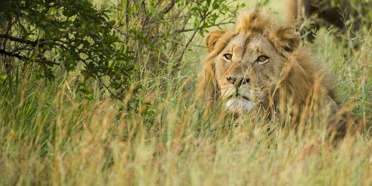- You are here:
- Home
- Countries & Parks
- Mozambique Parks
- Limpopo National Park
- Reviews
- Expert Reviews
Expert Reviews – Limpopo NP

Ariadne is a renowned African wildlife photographer whose work is featured in many well-known guidebooks and magazines.
2 people found this review helpful.
A 4x4 Wilderness Adventure
The 11,000km2 Limpopo National Park borders Kruger National Park on the South Africa side. Since the Great Limpopo Transfrontier Park treaty was signed in 2002, almost 5,000 animals have been translocated from Kruger to Limpopo National Park and 50km of fencing was dropped. Since then, the remaining fence hasn’t been maintained so animals are more or less free to move between the two parks. In 2006 a border post was erected to allow visitors to cross as well. This border post is mostly used by self-drive visitors from South Africa on their way to the Mozambican coast.
Aside from people driving through to hit the coast, there is very little tourism happening in Limpopo. Vast areas are totally inaccessible and facilities are very limited. Furthermore, large villages present within the park create a challenging environment for protecting the wildlife. Going forward, a voluntary resettlement program is under way.
Wanting to see a bit more of this wilderness area we entered the park from the Mozambican side in Mapai and we followed a very rough 4x4 route south. We camped wild above the magnificent Shingwedzi Cliffs overlooking the Shingwedzi River, the lifeline of the park. The next day we continued south to Massingir Dam where we stayed in the lovely Aguia Pesqueira Camp offering spectacular views over the lake.
In the 3 days we spent in the park, we saw very little wildlife. A few zebras, a herd of impalas and the occasional greater kudu crossing the road in front of us. All of it was very skittish. So currently, Limpopo isn’t really a wildlife destination, but if you’re looking for an off-the-beaten-track 4x4 adventure, it’s worth the detour if it’s not too far out of your way.

Philip is an acclaimed travel writer and author of many guidebooks, including the Bradt guides to Uganda, Tanzania, Kenya and South Africa.
A Work in Progress
On paper, Limpopo National Park is one of the most alluring safari destinations in southern Africa. A Mozambican extension of South Africa's world-famous Kruger National Park, it covers a vast area of 11,000km², making it the second-largest component (after Kruger) in the 100,000km² Great Limpopo Transfrontier Park. Better still, large parts of Limpopo National Park’s eastern border are now unfenced, meaning that Kruger’s wildlife – which includes all the Big Five and most other safari favourites – can cross into it unhindered.
Exciting as this sounds in theory, the reality is that Limpopo National Park is poorly developed for tourism and wildlife is difficult to see. The internal road system is limited to a couple of unsurfaced through routes and a few rough tracks, all of which require high clearance and 4x4. The only upmarket lodge closed down a few years back, meaning that accommodation options are limited to a few basic campsites and a solitary self-catering camp overlooking Lake Massingir in the far south. And even though wildlife is technically free to cross into the park from South Africa, discouraging factors include the high level of human encroachment and associated poaching, and a lack of perennial water sources (ironically, the impressive perennial river for which Limpopo NP is named is separated from the park by a narrow tract of community land).
Over three days in Limpopo National Park, driving from Mapai Gate to Massingir, we saw very few large mammals other than a few skittish buffalos, greater kudus, impalas and baboons. The birdlife was rather more impressive, with raptors being particularly well represented. Scenically, we found the park to be rather monotonous, though we did enjoy the spectacular Shingwedzi Cliffs, the views of Lake Massingir in the south and the remote wilderness feel of the little-used tracks. This vast park has immense potential, and management is working hard to rid it of poaching. Still, for the time being, I would recommend Limpopo National Park only to 4x4 enthusiasts looking for an off-the-beaten-track adventure or as a through route from Kruger to the Mozambican coast.
Average Expert Rating
- 2.0/5
- Wildlife
- Scenery
- Bush Vibe
- Birding
Rating Breakdown
- 5 star 0
- 4 star 0
- 3 star 0
- 2 star 2
- 1 star 0


 Mozambique Parks
Mozambique Parks